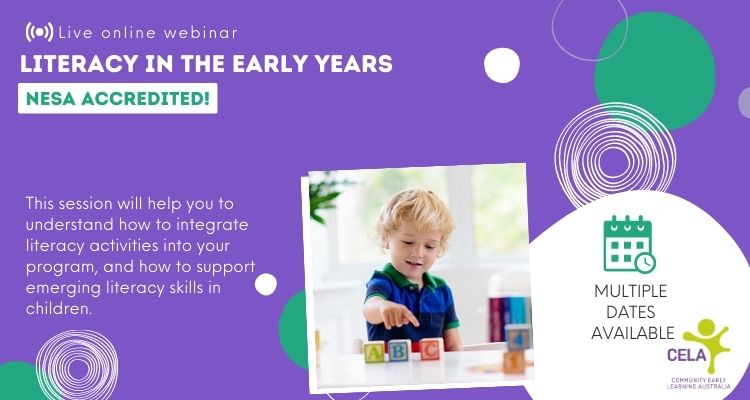I vividly remember the moment during my studies when a lecturer emphasised the power that reading storybooks aloud can have on children’s creativity, literacy, relationships and overall development. It still astonishes me that such a simple activity can be so powerful! This knowledge fills me with excitement each time I read aloud to children.
Social scientists now consider reading aloud to be of the most vital indicators of providing the best start to children’s lives (Gurdon, 2019). However, as I have progressed in my teaching career, working at a wide variety of services, I have seen that many educators don’t assign enough importance to reading aloud in their program. It made me wonder whether reading aloud from storybooks has slowly lost its place in this fast-paced digital age of distraction. When I stumbled across Meghan Cox Gurdon’s book “The Enchanted Hour”, it further convinced me of the hidden and ever-pervasive power of reading aloud for children, educators and adults (Gurdon, 2019).
The science behind these benefits
From birth to 8 years of age, children’s brains have a high degree of plasticity, which means the brain grows and develops as a result of experience (Gurdon, 2019). Listening to stories while looking at pictures stimulates children’s deep brain networks, supporting optimal cognitive development. In addition, children who have lots of stories read to them are more likely to turn into children who enjoy strong relationships, have sharper focus, and benefit from greater emotional resilience and self-mastery (Shickedanz & Collins, 2012; Gurdon, 2019).
Children who are more often read to or have access to a greater range of books show a higher level of receptiveness and early literacy development (Phillips, 2000). They also display higher creativity and imaginative capability as they are better able to visualise mental images (Gurdon, 2019).
The companionable aspect of shared reading cultivates empathy. Reading aloud is a gateway to a diverse range of vocabulary development and a pathway to early reading skills (Suggate et al., 2013). Utilising stories as a teaching tool also helps children to build their capability around sentence structure, vocabulary, rhythm, punctuation, and familiarity with new situations (Isik, 2016).
The benefits also flow on to adults. While we often have our attention pulled in countless directions, reading aloud can be a mentally nourishing exercise that offers reduced distractions.
Why reading aloud from books is better than watching video storybooks
Today’s technology has given us so much in terms of access to information, but it has also taken away so much from us. Although watching story videos and reading storybooks aloud together share a few similar features, the premises and effect are just not the same, as conveyed in the research on brain activation (Gurdon, 2019).
Watching video stories and engaging in screen time pulls individuals into their own little bubbles, but listening to storybooks being read aloud or engaging in shared reading draws people together in an imaginative and reciprocal bubble of joy and engagement (Suggate et al., 2013).
Exposing children to stories via videos can lead to overstimulation, while listening to storybooks being read aloud helps the brain to engage in deep and sustained attention (Gurdon, 2019).
The brain activations in children who are read stories show neurons firing and connecting together, indicating a higher-order brain network, compared to children who watch story videos with minimal neuron activation except for visual perceptions (Gurdon, 2019).
Reading stories aloud is an excellent teaching tool, which has many benefits for children and adults alike. Therefore, educators are encouraged to plan and reflect on their learning intentions, execution of the storytelling, and possible learning extensions such as activities or staging of the learning environment (Phillips, 2000; Anderson et al., 2003).
What about other variations of free storytelling (no books) or silent reading by children (reading independently)? Both also provide a rich number of benefits that bathes individuals of all ages, and engaging in various ways is encouraged for a meaningful learning experience (Suggate et al., 2013).
What other traditional methods of teaching do you think we need to change or refresh our understanding of?
Share your thoughts in the comments section.
References
Anderson, J., Anderson, A., Lynch, J., & Shapiro, J. (2003). On reading books to children: Parents and teachers. Chapter 3: Storybook sharing as cultural practice. University of British Columbia
Gurdon, M.C. (2019). The Enchanted Hour: The Miraculous Power of Reading Aloud in the Age of Distraction. Piatkus Publishing.
Isik, M.A. (2016). The impact of storytelling on young ages. European Journal of Language and Literature Studies, 2(3), 115-118.
Phillips, L. (2000). Storytelling – the seeds of children’s creativity. Australasian Journal of Early Childhood. DOI: 10.1177/183693910002500302
Shickedanz, J. & Collins, M.F. (2012). For young children, pictures in storybooks are rarely worth a thousand words. The Reading Teacher, 65(8), 539-549. DOI: 10.1002/TRTR.01080
Suggate, S.P., Lenhard, W., Neudecker, E., Schneider, W. (2013). Incidental vocabulary acquisition from stories: Second and fourth graders learn more from listening than reading. First Language, 33(6), 551-571. DOI: 10.1177/0142723713503144
Further reading:
Amplify! 8 top tips from a professional storyteller https://www.cela.org.au/publications/amplify!-blog/may-2017/telling-tales-for-children
Amplify! Connecting with families and community through Dolly Parton’s Imagination Library
https://cela.org.au/publications/amplify!-blog/june-2021/connecting-with-families-dolly-partons-library
Amplify! How reading to children links to emerging literacy https://cela.org.au/publications/amplify!-blog/july-2021/how-reading-to-children-links-to-emerging-literacy
Children’s Laureate, Gabrielle Wang Author shares her Top 5 Tips to spark a love of stories with little ones:
CELA training relating to this topic
